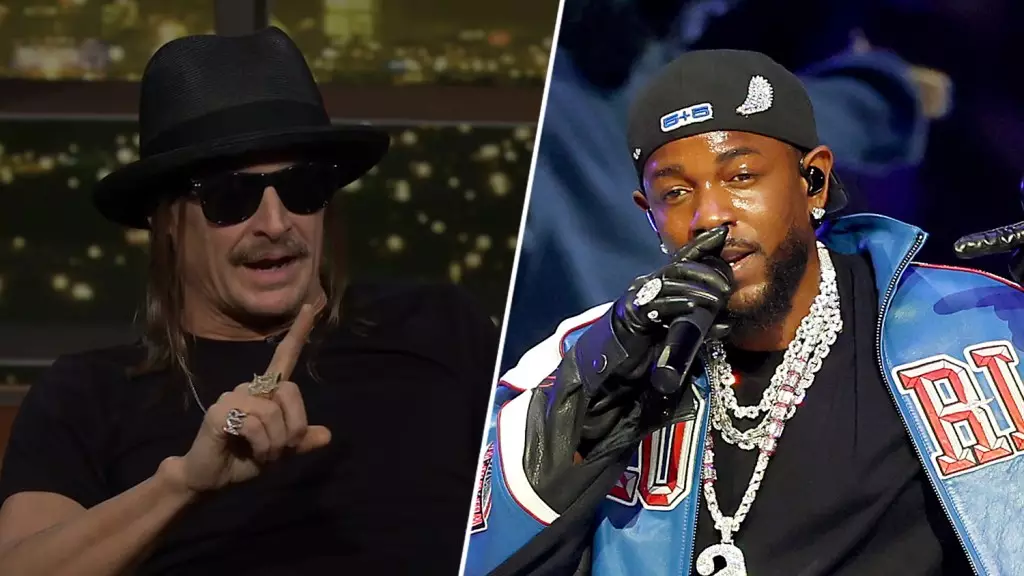Kendrick Lamar’s electrifying halftime performance at the Super Bowl undoubtedly left a memorable imprint on millions of viewers, stirring a medley of reactions that spanned the spectrum of appreciation to bewilderment. Among the most notable responses came from the multi-faceted Kid Rock, who articulated his sentiments on an episode of *Real Time with Bill Maher*. As someone who professes to understand the realms of hip-hop culture, his critique was laced with personal anecdotes and a desire to contextualize Lamar’s performance within a larger conversation about race, representation, and the dynamics of inclusion. However, his take raises critical questions about how we engage with art and who gets to define its cultural significance.
Kid Rock’s assertion that he “understands the culture” is laden with implications about authenticity and authority in cultural conversations. His reflections reveal an intricate fabric woven from his own experiences and appropriations of hip-hop. While he claims to have grown up immersed in the elements of hip-hop — breakdancing, DJing, and graffiti — it is worth questioning whether this immersion grants him any semblance of authority to critique a performance that, at its core, aims to celebrate Black voices.
Lamar’s act, laden with symbols and messages pertinent to Black culture, candidly presented his unfiltered reality. Kid Rock’s acknowledgment of this reality, paired with his seemingly superficial critique, raises the specter of performative allyship. His self-identification as a “cultural translator” comes with a troubling undertone; does his white perspective dilute the significance of an experience fundamentally different from his own, or does it inadvertently marginalize the very essence of that culture he seeks to respect?
The most contentious portion of Rock’s commentary stems from his interpretation of diversity, equity, and inclusion (DEI) within the NFL’s execution of the Super Bowl. His insistence that Lamar’s performance exemplifies the “epitome of DEI blowing up” provokes critical discourse on the expectations and effectiveness of DEI initiatives in predominantly white spaces. By framing it as an “IED” — an improvised explosive device — he simultaneously draws attention to the tension inherent in attempts to diversify a historically exclusionary platform.
Through Rock’s lens, the absence of white representation during Lamar’s performance symbolized a kind of rebellion against DEI initiatives that, in his narrative, fail to truly integrate diverse voices. However, this leads us to a pivotal question: should the presence of white artists or audiences be a prerequisite for validating the work of artists of color? This disruptive approach to representation underscores the controversy surrounding who has the right to occupy and dominate spaces structured around oppressive histories.
The references Rock made to figures like Colin Kaepernick invoke larger conversations about the intersections of activism and artistry. Kaepernick’s protest against racial injustice catalyzed national discussions about the role of sports in political spheres, directly influencing the cultural landscape that artists like Kendrick Lamar navigate. Rock’s suggestion that both Kendrick and Jay-Z owe Kaepernick their careers, thus blurring the lines between activism and artistic expression, hints at an uncomfortable narrative often overlooked: the collaborative effort required to push against systemic barriers.
This commentary underscores a paradox: while attempting to celebrate a historic moment in Black culture, Kid Rock inadvertently highlights an ongoing struggle within the industry for recognition and equity. Lamar’s performance was not merely entertainment; it was a multifaceted expression of identity that resonates deeply within social contexts, making Rock’s attempt to boil it down to a critique of exclusivity feel like a betrayal of its true essence.
Kendrick Lamar’s Super Bowl halftime performance undeniably sparked dialogues that transcend mere entertainment. Kid Rock’s reaction, while rooted in personal experience and cultural understanding, serves to remind us of the complexities and controversies surrounding race, representation, and the evolving landscape of cultural critique. As audiences and commentators, our interpretations must transcend simplistic narratives, engaging in deep and nuanced conversations that honor, rather than dilute, the collaborative spirit of cultural expression. In a world that is constantly changing, the bridge between understanding and appreciation remains a crucial frontier to explore, ensuring an authentic connection to the art that defines our times.
